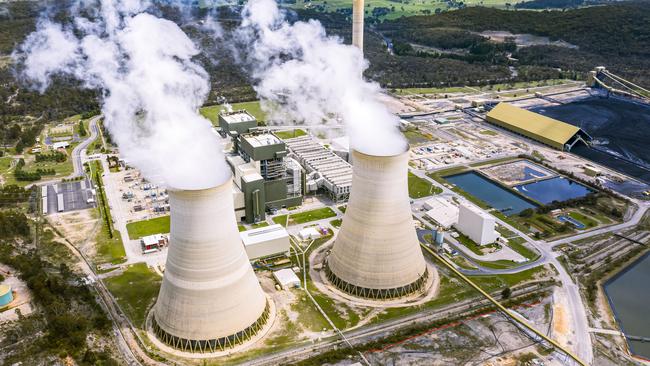Energy prices smash records as coal generation slumps
The scale of Australia’s energy crisis has been laid bare with wholesale power and gas prices surging to new highs after coal generation hit its lowest level of supply on record.

The scale of Australia’s energy crisis has been laid bare with wholesale power and gas prices surging to new highs after coal generation plummeted to its lowest level of supply on record.
Wholesale electricity prices more than tripled in the second quarter of 2022 to average $264 per megawatt hour compared with $87MWh in the first three months of this year, the Australian Energy Market Operator said, with Queensland and NSW posting the highest prices.
Gas prices across the east coast markets also soared to more than $28 per gigajoule on average from less than $10/GJ in the first quarter, and peaked at more than $41/GJ on June 30, exceeding international LNG netback prices in both May and June as Russia’s restrictions on supply roiled global markets.
The collapse of black coal-fired generation contributed to the price hit with a string of plant breakdowns and supply shortages resulting in the fossil fuel recording its lowest second quarter output since the national electricity market began in 1998. Coal, which normally accounts for 60 per cent of supply, fell to 43 per cent in the three months to June 30.
The amount of coal out of action hit a peak of 4600MW in June, nearly 10 per cent of the entire capacity of the power grid.
The supply squeeze, along with high gas prices, saw wholesale energy prices jump which forced AEMO to impose a price cap. Some high cost producers refused to supply the market over fears of running at a loss, eventually forcing the entire market to be suspended amid accusations from Anthony Albanese that generators were essentially “gaming the system”.
More than 400 separate lack of reserve conditions were declared by AEMO in the second quarter, compared with 36 in the March quarter and 73 a year earlier.
While the suspension was lifted after a week, a gas price cap remains in place for Victoria while an emergency guarantee mechanism was triggered to help arrest shortfalls in the state where demand surges threefold in winter.
Gas and renewables filled the gap left by the coal generation sitting on the sidelines. Gas generation jumped 27 per cent or 472MW from the same time a year ago to reach its highest second quarter level since 2017, while clean energy supply grew by a fifth over the same period although it remained seasonally lower than the first quarter of this year. “Wholesale energy price hikes and volatility were driven by multiple factors, including high international commodity prices, coal-fired generation outages, elevated levels of gas-fired generation, fuel supply issues, and many east coast cities experiencing their coldest start to June in decades,” AEMO executive Violette Mouchaileh said in its quarterly energy dynamics report.
AEMO reinforced its call for Australia to accelerate a move away from coal to renewables and storage and urgently sanction more than $10bn of transmission projects to escape the ongoing threat of blackouts and high power prices amid a national energy crisis.
“What’s clear is the urgent need to build-out renewable energy with diversified firming generation – like batteries, hydro and gas – and transmission investment to provide homes and businesses with low-cost, reliable energy.”
Separately, rooftop solar installations fell to their lowest level in three years for the three months to June 30 with households paying $1000 more for the same system due to higher costs and supply snags, the Australian Energy Council said.
Solar installed on rooftops fell by more than half in the second quarter of 2022 to 52,950 systems from 109,000 for the same time a year earlier and 86,000 in 2020. A reporting lag means this year’s figure will likely be bumped up to 80,000 installations, indicating just over a quarter fewer systems put in place.
Households in 2022 are typically paying $1000 more for the same solar set-up their neighbours paid last year, fuelling hesitancy which has been amplified by cost of living pressures and economic jitters.
The cost hike was triggered by supply chain issues, the increased cost of polysilicon which is used to make solar cells, and a reduction in subsidies paid through small-scale technology certificates.
The number of STCs a rooftop solar system creates falls each year through to 2030 when the scheme ends.
The average installed solar system size for residential households has more than tripled over the last decade to 9.54 kilowatts from 2.65kW in January 2012.
The Victorian postcodes of 3029 – Hoppers Crossing, Tarneit and Truganina – and 3064 – Donnybrook – were first and second respectively for the biggest solar uptake in Australia while the NSW postcode of 2765 in Sydney’s northwest was third.
South Australia and NSW account for more than half the market for those combining solar and batteries, with Queensland lagging after its incentive scheme was exhausted in 2019.
Over 3.1 million households have added solar to their rooftops since the turn of the century, adding 15 gigawatts of capacity to the national electricity market.



To join the conversation, please log in. Don't have an account? Register
Join the conversation, you are commenting as Logout